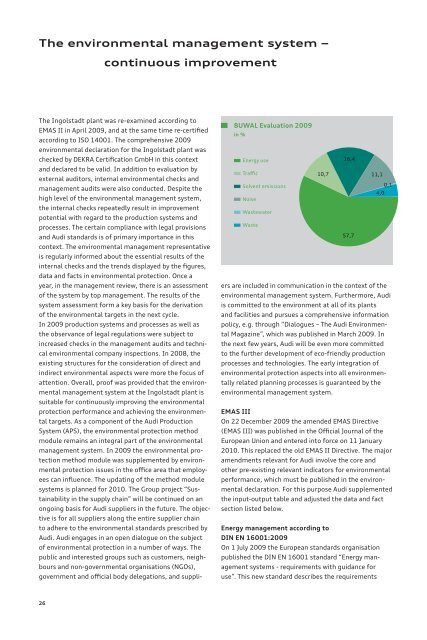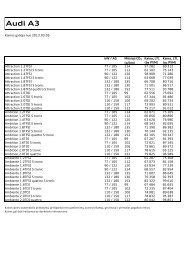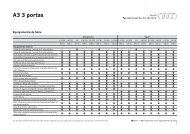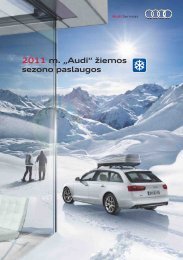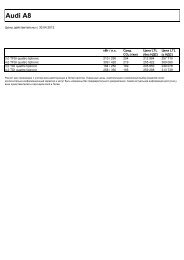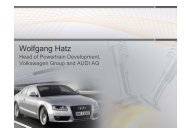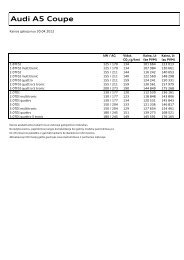Environmental Declaration 2010 for the Audi Plant in Ingolstadt
Environmental Declaration 2010 for the Audi Plant in Ingolstadt
Environmental Declaration 2010 for the Audi Plant in Ingolstadt
You also want an ePaper? Increase the reach of your titles
YUMPU automatically turns print PDFs into web optimized ePapers that Google loves.
The environmental management system –<br />
The <strong>Ingolstadt</strong> plant was re-exam<strong>in</strong>ed accord<strong>in</strong>g to<br />
EMAS II <strong>in</strong> April 2009, and at <strong>the</strong> same time re-certified<br />
accord<strong>in</strong>g to ISO 14001. The comprehensive 2009<br />
environmental declaration <strong>for</strong> <strong>the</strong> <strong>Ingolstadt</strong> plant was<br />
checked by DEKRA Certification GmbH <strong>in</strong> this context<br />
and declared to be valid. In addition to evaluation by<br />
external auditors, <strong>in</strong>ternal environmental checks and<br />
management audits were also conducted. Despite <strong>the</strong><br />
high level of <strong>the</strong> environmental management system,<br />
<strong>the</strong> <strong>in</strong>ternal checks repeatedly result <strong>in</strong> improvement<br />
potential with regard to <strong>the</strong> production systems and<br />
processes. The certa<strong>in</strong> compliance with legal provisions<br />
and <strong>Audi</strong> standards is of primary importance <strong>in</strong> this<br />
context. The environmental management representative<br />
is regularly <strong>in</strong><strong>for</strong>med about <strong>the</strong> essential results of <strong>the</strong><br />
<strong>in</strong>ternal checks and <strong>the</strong> trends displayed by <strong>the</strong> figures,<br />
data and facts <strong>in</strong> environmental protection. Once a<br />
year, <strong>in</strong> <strong>the</strong> management review, <strong>the</strong>re is an assessment<br />
of <strong>the</strong> system by top management. The results of <strong>the</strong><br />
system assessment <strong>for</strong>m a key basis <strong>for</strong> <strong>the</strong> derivation<br />
of <strong>the</strong> environmental targets <strong>in</strong> <strong>the</strong> next cycle.<br />
In 2009 production systems and processes as well as<br />
<strong>the</strong> observance of legal regulations were subject to<br />
<strong>in</strong>creased checks <strong>in</strong> <strong>the</strong> management audits and technical<br />
environmental company <strong>in</strong>spections. In 2008, <strong>the</strong><br />
exist<strong>in</strong>g structures <strong>for</strong> <strong>the</strong> consideration of direct and<br />
<strong>in</strong>direct environmental aspects were more <strong>the</strong> focus of<br />
attention. Overall, proof was provided that <strong>the</strong> environmental<br />
management system at <strong>the</strong> <strong>Ingolstadt</strong> plant is<br />
suitable <strong>for</strong> cont<strong>in</strong>uously improv<strong>in</strong>g <strong>the</strong> environmental<br />
protection per<strong>for</strong>mance and achiev<strong>in</strong>g <strong>the</strong> environmental<br />
targets. As a component of <strong>the</strong> <strong>Audi</strong> Production<br />
System (APS), <strong>the</strong> environmental protection method<br />
module rema<strong>in</strong>s an <strong>in</strong>tegral part of <strong>the</strong> environmental<br />
management system. In 2009 <strong>the</strong> environmental protection<br />
method module was supplemented by environmental<br />
protection issues <strong>in</strong> <strong>the</strong> office area that employees<br />
can <strong>in</strong>fluence. The updat<strong>in</strong>g of <strong>the</strong> method module<br />
systems is planned <strong>for</strong> <strong>2010</strong>. The Group project “Susta<strong>in</strong>ability<br />
<strong>in</strong> <strong>the</strong> supply cha<strong>in</strong>” will be cont<strong>in</strong>ued on an<br />
ongo<strong>in</strong>g basis <strong>for</strong> <strong>Audi</strong> suppliers <strong>in</strong> <strong>the</strong> future. The objective<br />
is <strong>for</strong> all suppliers along <strong>the</strong> entire supplier cha<strong>in</strong><br />
to adhere to <strong>the</strong> environmental standards prescribed by<br />
<strong>Audi</strong>. <strong>Audi</strong> engages <strong>in</strong> an open dialogue on <strong>the</strong> subject<br />
of environmental protection <strong>in</strong> a number of ways. The<br />
public and <strong>in</strong>terested groups such as customers, neighbours<br />
and non-governmental organisations (NGOs),<br />
government and official body delegations, and suppli-<br />
26<br />
cont<strong>in</strong>uous improvement<br />
BUWAL Evaluation 2009<br />
<strong>in</strong> %<br />
Energy use<br />
Traffic<br />
Solvent emissions<br />
Noise<br />
Wastewater<br />
Waste<br />
10,7<br />
16,4<br />
57,7<br />
11,1<br />
ers are <strong>in</strong>cluded <strong>in</strong> communication <strong>in</strong> <strong>the</strong> context of <strong>the</strong><br />
environmental management system. Fur<strong>the</strong>rmore, <strong>Audi</strong><br />
is committed to <strong>the</strong> environment at all of its plants<br />
and facilities and pursues a comprehensive <strong>in</strong><strong>for</strong>mation<br />
policy, e.g. through “Dialogues – The <strong>Audi</strong> <strong>Environmental</strong><br />
Magaz<strong>in</strong>e”, which was published <strong>in</strong> March 2009. In<br />
<strong>the</strong> next few years, <strong>Audi</strong> will be even more committed<br />
to <strong>the</strong> fur<strong>the</strong>r development of eco-friendly production<br />
processes and technologies. The early <strong>in</strong>tegration of<br />
environmental protection aspects <strong>in</strong>to all environmentally<br />
related plann<strong>in</strong>g processes is guaranteed by <strong>the</strong><br />
environmental management system.<br />
EMAS III<br />
On 22 December 2009 <strong>the</strong> amended EMAS Directive<br />
(EMAS III) was published <strong>in</strong> <strong>the</strong> Official Journal of <strong>the</strong><br />
European Union and entered <strong>in</strong>to <strong>for</strong>ce on 11 January<br />
<strong>2010</strong>. This replaced <strong>the</strong> old EMAS II Directive. The major<br />
amendments relevant <strong>for</strong> <strong>Audi</strong> <strong>in</strong>volve <strong>the</strong> core and<br />
o<strong>the</strong>r pre-exist<strong>in</strong>g relevant <strong>in</strong>dicators <strong>for</strong> environmental<br />
per<strong>for</strong>mance, which must be published <strong>in</strong> <strong>the</strong> environmental<br />
declaration. For this purpose <strong>Audi</strong> supplemented<br />
<strong>the</strong> <strong>in</strong>put-output table and adjusted <strong>the</strong> data and fact<br />
section listed below.<br />
Energy management accord<strong>in</strong>g to<br />
DIN EN 16001:2009<br />
On 1 July 2009 <strong>the</strong> European standards organisation<br />
published <strong>the</strong> DIN EN 16001 standard “Energy management<br />
systems - requirements with guidance <strong>for</strong><br />
use”. This new standard describes <strong>the</strong> requirements<br />
0,1<br />
4,0<br />
<strong>Environmental</strong> per<strong>for</strong>mance assessment<br />
<strong>for</strong> an energy management system that is <strong>in</strong>tended<br />
to enable companies to evaluate energy consumption<br />
systematically <strong>in</strong> order to achieve cont<strong>in</strong>uous improvement<br />
<strong>in</strong> energy efficiency and lower costs. For <strong>the</strong> most<br />
part, DIN EN 160001 is structurally oriented towards<br />
<strong>the</strong> standard DIN EN ISO 14001, which is <strong>the</strong> central<br />
component of <strong>the</strong> EMAS regulation. The major environmental<br />
effects at <strong>Audi</strong> are connected to <strong>the</strong> key subject<br />
of energy. Cont<strong>in</strong>uous improvement <strong>in</strong> <strong>the</strong> subject area<br />
of energy and resource sav<strong>in</strong>gs is an <strong>in</strong>tegral component<br />
of <strong>the</strong> environmental management system – from <strong>the</strong><br />
<strong>Audi</strong> environmental policy, <strong>the</strong> determ<strong>in</strong>ation of specific<br />
Percentage share of total environmental pollution<br />
Period under consideration<br />
<strong>Environmental</strong> per<strong>for</strong>mance assessment:<br />
Reduction of pollution <strong>in</strong> 2009<br />
<strong>Audi</strong> uses an environmental per<strong>for</strong>mance assessment<br />
process based on <strong>the</strong> methodology of <strong>the</strong> Swiss Federal<br />
Office <strong>for</strong> <strong>the</strong> Environment, Forestry and Agriculture<br />
(BUWAL) <strong>in</strong> order to record <strong>the</strong> environmental effects<br />
result<strong>in</strong>g from <strong>the</strong> activities at <strong>the</strong> plant. This process<br />
has been adapted to <strong>the</strong> circumstances at <strong>the</strong><br />
<strong>Ingolstadt</strong> plant by <strong>the</strong> application of appropriate<br />
ecological factors.<br />
The scientific system accord<strong>in</strong>g to BUWAL is based on<br />
<strong>the</strong> aspect of <strong>the</strong> ecological shortage of a resource,<br />
calculated from <strong>the</strong> current and critical flow.<br />
In succession, an eco-factor is calculated, which is<br />
multiplied by <strong>the</strong> emissions or <strong>the</strong> consumption of a<br />
resource. This produces environmental pollution<br />
po<strong>in</strong>ts, which are used <strong>for</strong> absolute and percentagebased<br />
evaluations of <strong>the</strong> environmental effects.<br />
As a result of a comprehensive revision <strong>in</strong> 2008, only a<br />
departmental objectives and <strong>in</strong>ternal audits to <strong>the</strong> management<br />
review. To give <strong>the</strong> issue of energy even more<br />
weight, <strong>the</strong> <strong>Audi</strong> environmental policy has been supplemented<br />
with <strong>the</strong> addition of “spar<strong>in</strong>g and efficient use<br />
of resources and energy”.<br />
Consequently, <strong>the</strong> requirements of DIN EN 16001 will<br />
be <strong>in</strong>cluded <strong>in</strong> future checks when monitor<strong>in</strong>g <strong>the</strong> <strong>Audi</strong><br />
environmental management system. As a result, <strong>the</strong><br />
<strong>Audi</strong> environmental management system covers <strong>the</strong><br />
requirements of EMAS III and DIN EN ISO 14001 and<br />
DIN EN 16001 <strong>in</strong>tegrated <strong>in</strong> it.<br />
MUBP* % MUBP* %<br />
Energy use 4.073,01 59,4 3.845,89 57,7<br />
Traffic 733,71 10,7 715,21 10,7<br />
Solvent emissions 1.040,20 15,2 1.095,60 16,4<br />
Noise 741,28 10,8 741,28 11,1<br />
Wastewater 4,09 0,1 3,61 0,1<br />
Waste 259,67 3,8 264,50 4,0<br />
Number of vehicles 591.559,00 – 598.161,00 –<br />
Total 6.851,97 100,0 6.666,09 100,0<br />
*MUBP = mega environmental pollution po<strong>in</strong>ts accord<strong>in</strong>g to BUWAL (rounded)<br />
2008 2009<br />
comparison of <strong>the</strong> calculations from 2008 and 2009<br />
is possible.<br />
The major environmental effects at <strong>the</strong> plant <strong>in</strong> 2009<br />
were also attributable to energy consumption as well<br />
as solvent emissions and traffic or noise (see chart).<br />
When compared with <strong>the</strong> environmental pollution<br />
po<strong>in</strong>ts <strong>in</strong> 2008 and 2009 it is evident that <strong>the</strong> environmental<br />
effects have decl<strong>in</strong>ed. Especially as a result of<br />
<strong>the</strong> lower energy consumption, <strong>the</strong> associated<br />
environmental effects decl<strong>in</strong>ed.<br />
Due to <strong>the</strong> <strong>in</strong>creased vehicle production, <strong>the</strong> environmental<br />
pollution as a result of solvent emissions rose<br />
slightly from 2008 to 2009.<br />
The lower environmental pollution po<strong>in</strong>ts <strong>in</strong> <strong>the</strong> area of<br />
traffic (supplier and employee traffic) can be expla<strong>in</strong>ed<br />
by a lower number of work<strong>in</strong>g days.<br />
Noise emissions changed only slightly from 2008 to<br />
2009, as a result of which <strong>the</strong> environmental pollution<br />
po<strong>in</strong>ts here did not alter.<br />
27


